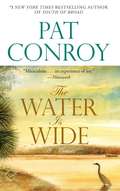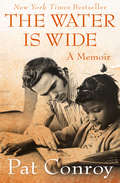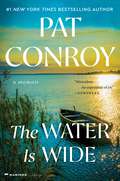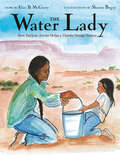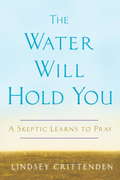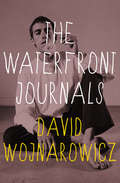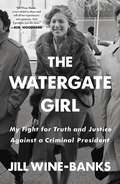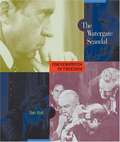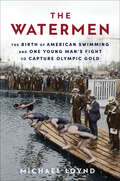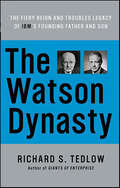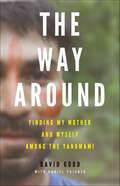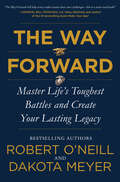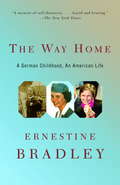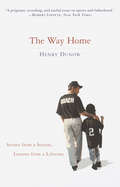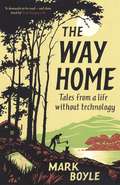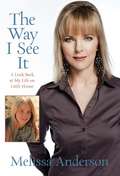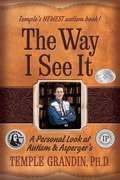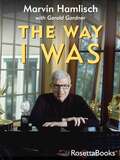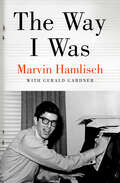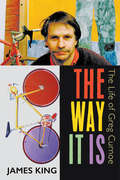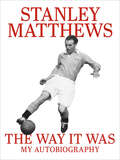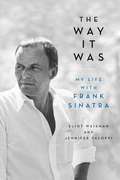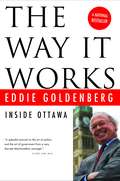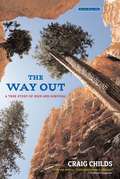- Table View
- List View
The Water Is Wide: A Memoir
by Pat ConroyThe book is Pat Conroy's extraordinary drama based on his own experience the true story of a man who gave a year of his life to an island and the new life its people gave him.
The Water Is Wide: A Memoir
by Pat ConroyThe bestselling Pat Conroy memoir--now available as an ebookThe moving story of a young teacher's experience on an island forgotten by the worldThough the children of Yamacraw Island live less than two miles from the coast of South Carolina, they can't name the president or the ocean that surrounds them. Many can't sign their names. Most can't read or write--they're unable to reach their potential to grow and learn because they have been failed by their school district and handicapped by their poverty and isolation. But with the arrival of an eager young teacher, their prospects begin to brighten.Based on Pat Conroy's experiences teaching elementary school for a year on South Carolina's Daufuskie Island, The Water Is Wide is a revealing portrait of the inequalities of the American education system and a powerful story of the group of children that changed one man's life forever.
The Water Is Wide: A Memoir
by Pat Conroy“A powerfully moving book . . . You will laugh, you will weep, you will be proud and you will rail.” —Charleston News and CourierYamacraw Island was haunting, nearly deserted, and beautiful. Separated from the mainland of South Carolina by a wide tidal river, it was accessible only by boat. But for the handful of families that lived on Yamacraw, America was a world away. For years these families lived proudly from the sea until waste from industry destroyed the oyster beds essential to their very existence. Already poor, they knew they would have to face an uncertain future unless, somehow, they learned a new life. But they needed someone to teach them, and their rundown schoolhouse had no teacher.The Water Is Wide is Pat Conroy’s extraordinary memoir based on his experience as one of two teachers in a two-room schoolhouse, working with children the world had pretty much forgotten. It was a year that changed his life, and one that introduced a group of poor Black children to a world they did not know existed.“A hell of a good story.” —The New York Times“[Pat] Conroy cuts through his experiences with a sharp edge of irony. . . . He brings emotion, writing talent and anger to his story.” —Baltimore Sun
The Water Lady: How Darlene Arviso Helps a Thirsty Navajo Nation
by Alice B. McGintyThis inspiring picture book tells the true story of a woman who brings desperately needed water to families on the Navajo reservation every day. Underneath the New Mexico sky, a Navajo boy named Cody finds that his family's barrels of water are empty. He checks the chicken coop-- nothing. He walks down the road to the horses' watering hole. Dry. Meanwhile, a few miles away, Darlene Arviso drives a school bus and picks up students for school. After dropping them off, she heads to another job: she drives her big yellow tanker truck to the water tower, fills it with three thousand gallons of water, and returns to the reservation, bringing water to Cody's family, and many, many others. Here is the incredible and inspiring true story of a Native American woman who continuously gives back to her community and celebrates her people.
The Water Will Hold You: A Skeptic Learns to Pray
by Lindsey CrittendenThe first time she said those words, suggested to her by an Episcopal priest, Lindsey Crittenden was riddled with misgivings. She didn't pray or attend church services--she wasn't even sure she believed in God--but the simple phrase held a soothing power she couldn't deny. Unlike the prayers of her childhood with their vague references to forgiving trespasses and dying before you wake, this felt solid. I am here was incontestable, certain. You are here confirmed the existence of a world outside herself and eased the knot of isolation Lindsey had been carrying with her since the day her brother died. She soon found that she couldn't pray enough. She spoke to God; she questioned God; and as a result, she came to a deeper understanding of herself and the world around her. Prayer opened Crittenden up to the present and to those around her. It gave her strength when her mother, and then her father, became ill, and when her late brother's young son became increasingly hers to care for. But when a relationship went sour, prayer abandoned her. Or so it seemed, until she learned the most important lesson of all. Poignant, personal, and surprisingly honest, The Water Will Hold You is a skeptic's story as much as it is a believer's story. It explores the power of the ineffable through a compelling narrative of family, loss, and love. Lindsey Crittenden has emerged as a fresh new voice with a message to cross spiritual and religious lines: Faith is constant discovery.
The Waterfront Journals
by David WojnarowiczVoices from the margins of American life tell tales of trickery, betrayal, sex, and defeat in these short monologues by &“a spokesman for the unspeakable&” (New York magazine). In his full but regrettably brief lifetime, David Wojnarowicz was many things: a visual and performance artist whose radical work incensed the right-wing establishment, a tireless AIDS and anticensorship activist, and, most emphatically, a writer. His Waterfront Journals are a remarkable collection of fictionalized stories spoken in the voices of unforgettable characters the author met during his time spent living on America&’s streets and traveling her back roads. The narrators speak from the heart and from the depths of despair, creating an often shocking and powerfully moving mosaic of life in the shadows. Here are junkies and boy hustlers, truckers and hoboes. A runner tells of his encounter with two drug-using priests who openly and proudly discuss their various sexual exploits. Whores tell of johns who brutalized them and corrupt cops who did the same. A young man relays his tale of a seedy movie balcony pickup and his shocking discovery that his &“date&” was not who she seemed. Another man describes sex with an amputee Vietnam veteran. Each of their stories stuns with hard and haunting truths that will leave the reader staggered and breathless, yet exhilarated. From a Lambda Literary Award winner and the subject of a new documentary by Chris McKim, these are &“dispatches from that region of dissolute grace at the city&’s edge&” (Time Out New York).
The Watergate Girl: My Fight for Truth and Justice Against a Criminal President
by Jill Wine-BanksObstruction of justice, the specter of impeachment, sexism at work, shocking revelations: Jill Wine-Banks takes us inside her trial by fire as a Watergate prosecutor. It was a time, much like today, when Americans feared for the future of their democracy, and women stood up for equal treatment. At the crossroads of the Watergate scandal and the women’s movement was a young lawyer named Jill Wine Volner (as she was then known), barely thirty years old and the only woman on the team that prosecuted the highest-ranking White House officials. Called “the mini-skirted lawyer” by the press, she fought to receive the respect accorded her male counterparts—and prevailed.In The Watergate Girl, Jill Wine-Banks opens a window on this troubled time in American history. It is impossible to read about the crimes of Richard Nixon and the people around him without drawing parallels to today’s headlines. The book is also the story of a young woman who sought to make her professional mark while trapped in a failing marriage, buffeted by sexist preconceptions, and harboring secrets of her own. Her house was burgled, her phones were tapped, and even her office garbage was rifled through.At once a cautionary tale and an inspiration for those who believe in the power of justice and the rule of law, The Watergate Girl is a revelation about our country, our politics, and who we are as a society.
The Watergate Scandal (Cornerstones of Freedom)
by Dan ElishDetails the events of the scandal called Watergate, including the major players, how the facts were uncovered, and the way in which the events ultimately reaffirmed basic principles of the Constitution.
The Watermen: The Birth of American Swimming and One Young Man's Fight to Capture Olympic Gold
by Michael LoyndThe feel-good underdog story of &“one of the most fascinating people not only in the sport of swimming but in all of athletics&” (Olympic gold medalist Rowdy Gaines): the first American swimmer to win Olympic gold, set against the turbulent rebirth of the modern Games—for fans of The Boys in the Boat and Seabiscuit&“A truly compelling story of athletic triumph, individual perseverance in the face of adversity, and significant social history.&”—Bob Costas, former NBC host of twelve Olympic GamesIn the early twentieth century, few Americans knew how to swim, and swimming as a competitive sport was almost unheard of. That is, until Charles Daniels took to the water.On the surface, young Charles had it all: high-society parents, a place at an exclusive New York City prep school, summer vacations in the Adirondacks. But the scrawny teenager suffered from extreme anxiety thanks to a sadistic father who mired the family in bankruptcy and scandal before abandoning Charles and his mother altogether. Charles&’s only source of joy was swimming. But with no one to teach him, he struggled with technique—until he caught the eye of two immigrant coaches hell-bent on building a U.S. swim program that could rival the British Empire&’s seventy-year domination of the sport.Interwoven with the story of Charles&’s efforts to overcome his family&’s disgrace is the compelling history of the struggle to establish the modern Olympics in an era when competitive sports were still in their infancy. When the powerful British Empire finally legitimized the Games by hosting the fourth Olympiad in 1908, Charles&’s hard-fought rise climaxed in a gold-medal race where British judges prepared a trap to ensure the American upstart&’s defeat.Set in the early days of a rapidly changing twentieth century, The Watermen—a term used at the time to describe men skilled in water sports—tells an engrossing story of grit, of the growth of a major new sport in which Americans would prevail, and of a young man&’s determination to excel.
The Watson Dynasty: The Fiery Reign and Troubled Legacy of IBM's Founding Father and Son
by Richard S. TedlowThis account of IBM’s famed father-and-son CEOs and the family conflicts behind the scenes is “a revealing look at the making of corporate America” (Publishers Weekly).For an extraordinary fifty-seven-year period, one of the nation's largest and fastest-growing companies was run by two men who were flesh and blood. The chief executives of the International Business Machines Corporation from 1914 until 1971 were Thomas J. Watson, Sr. and Thomas J. Watson, Jr., and that great corporation bears the imprint of both men’s ambitions and strengths—but it also bears the consequences of a family that was in near-constant conflict.Sometimes wrong but never in doubt, both Watsons had clear and farsighted visions of what their company could become. They also had volcanic tempers. Their fights with each other combined with their commitment to leadership and excellence made IBM one of the most rewarding yet gut-clutching firms to work for in the history of American business.Our expectations of professional behavior include leaving emotions and vulnerabilities at home each day. In the case of the Watsons, filial and sibling strife could not be excluded from the office. In closely studying the desires and frustrations of the Watson family, eminent historian Richard S. Tedlow has produced something more than a family portrait or a company history. He delves into the role of emotion in corporate life, and explores the interplay between the personalities of these two extraordinary men and the firm they created. Both Watsons had deeply held beliefs about what a corporation is and should be. These ideas helped make “Big Blue” the bluest of blue-chip stocks during their long tenure. These very beliefs, however, also sowed the seeds for IBM’s disasters in the late 1980s and early 1990s, when the company had lost sight of the original meaning behind many of the practices each man put into place. Tracing the family’s idiosyncratic ability to cope with each other’s weaknesses but not their strengths, The Watson Dynasty is a “highly readable” portrait of a towering pioneer of the technology industry and the father and son who built it (Library Journal).“Crisp, engaging.” —Enterprise & Society
The Way Around: Finding My Mother and Myself Among the Yanomami
by David GoodRooted in two vastly different cultures, a young man struggles to understand himself, find his place in the world, and reconnect with his mother—and her remote tribe in the deepest jungles of the Amazon rainforest—in this powerful memoir that combines adventure, history, and anthropology.“My Yanomami family called me by name. Anyopo-we. What it means, I soon learned, is ‘long way around’: I’d taken the long way around obstacles to be here among my people, back where I started. A twenty-year detour.”For much of his young life, David Good was torn between two vastly different worlds. The son of an American anthropologist and a tribeswoman from a distant part of the Amazon, it took him twenty years to embrace his identity, reunite with the mother who left him when he was six, and claim his heritage.The Way Around is Good’s amazing chronicle of self-discovery. Moving from the wilds of the Amazonian jungle to the paved confines of suburban New Jersey and back, it is the story of his parents, his American scientist-father and his mother who could not fully adapt to the Western lifestyle. Good writes sympathetically about his mother’s abandonment and the deleterious effect it had on his young self; of his rebellious teenage years marked by depression and drinking, and the near-fatal car accident that transformed him and gave him purpose to find a way back to his mother.A compelling tale of recovery and discovery, The Way Around is a poignant, fascinating exploration of what family really means, and the way that the strongest bonds endure, even across decades and worlds.
The Way Forward: Master Life's Toughest Battles and Create Your Lasting Legacy
by Robert O'Neill Dakota Meyer“The Way Forward will help every reader master their own challenges—this is a must-read book!” —Admiral Bill McRaven, U.S. Navy (Retired) and author of the #1 New York Times bestseller Make Your BedAmerican Sniper meets Make Your Bed in these life lessons from decorated United States service members and New York Times bestselling authors Robert O’Neill and Dakota Meyer—an in-depth, fearless, and ultimately redemptive account of what it takes to survive and thrive on battlefields from Afghanistan and Iraq to our daily lives, and how the perils of war help us hold onto our humanity.Rob O’Neill and Dakota Meyer are two of the most decorated and recognized US service members: O’Neill killed the world’s most wanted man, Osama bin Laden, and Meyer was the first living Marine to receive the Medal of Honor since the Vietnam War. But beyond their actions and courage in combat, O’Neill and Meyer also have much in common in civilian life: they are both sought-after public speakers, advocates for veterans, and share a non-PC sense of humor. Combining the best of military memoirs and straight-talking self-help, The Way Forward alternates between O’Neill’s and Meyer’s perspectives, looking back with humor at even the darkest war stories, and sharing lessons they learned along the way.The Way Forward presents O’Neill and Meyer’s philosophy in combat and life. This isn’t a book about the glory of war and combat, but one about facing your enemies, some who are flesh and blood and some that are not: Your thoughts. Your doubts. Your boredom and your regrets. From Rob’s dogged repetition at the free throw line of his childhood basketball court to Dakota’s pursuit of EMT and firefighter credentials to aid accident victims, these two American heroes turn their experiences into valuable lessons for every reader. Gritty and down-to-earth, O’Neill and Meyer tell their stories with candor and vulnerability to help readers handle stress, tackle their biggest obstacles, and exceed their expectations of themselves, while keeping life’s battles in perspective with a sense of humor.
The Way Home
by Ernestine BradleyGrowing up in Bavaria during World War II, Ernestine Bradley came to know wartime dislocations and food shortages, along with the challenges of taking care of her siblings while her mother was ill. The men of her hometown were away at war, but their absence created an exciting unexpected freedom–a freedom she sought again at 21 when she became a stewardess, moved to New York and went on to marry a shy basketball star who played for the New York Knicks. Yet the paradoxes of her childhood shaped Bradley’s life. Her hard-won discipline helped her maintain a full-time career as a professor while she commuted weekly to Washington and her husband’s public life; and Germany’s literary response to the holocaust of which she had been unaware became her scholarly passion. Cancer confronted her with a personal war, ultimately demanding a vulnerability she had never allowed herself. Frank, warm, and deeply moving,The Way Homeis an inspiring American story.
The Way Home: Scenes from a Season, Lessons from a Lifetime
by Henry Dunow: When Henry Dunow signs up to coach his son Max's Little League team on Manhattan's Upper West Side, he finds himself looking back on his own childhood and his father, Moishe, a Yiddish writer and refugee from Hitler's Europe, who had considered recreation like playing catch with his son narishkeit, "foolishness." Determined to be a different kind of parent to his first grader, Dunow bumbles through a self-test of fatherhood on the scruffy fields of New York's Riverside Park, playing coach, cheerleader, father, and friend to a ragtag bunch of seven-year-olds, many of whom are discovering baseball for the first time. The Way Home is the affecting and ironic story of Dunow's journey of discovery as he watches his relationship with Max evolve over the course of a Little League season, and comes to understand what being a father to his son can teach him about the man who was his own father.
The Way Home: Tales from a Life Without Technology
by Mark BoyleIt was 11pm when I checked my email for the last time and turned off my phone for what I hoped would be forever. No running water, no car, no electricity or any of the things it powers: the internet, phone, washing machine, radio or light bulb. Just a wooden cabin, on a smallholding, by the edge of a stand of spruce. In this honest and lyrical account of a remarkable life without modern technology, Mark Boyle explores the hard won joys of building a home with his bare hands, learning to make fire, collecting water from the spring, foraging and fishing. What he finds is an elemental life, one governed by the rhythms of the sun and seasons, where life and death dance in a primal landscape of blood, wood, muck, water, and fire – much the same life we have lived for most of our time on earth. Revisiting it brings a deep insight into what it means to be human at a time when the boundaries between man and machine are blurring.
The Way I See It
by Joseph K. ChanThis book offers hope and inspiration to: <P><P> <li>People who are visually impaired <li>People who have other bodily impairments <li>Parents who have a physically challenged child <li>People who ponder about the purpose of life <P><P>Born with not one, but two rather restrictive birth defects, Joseph Chan faced multiple challenges in coping as a little child. In addition to the stress of keeping up in school, the stigma of being different experienced in both his family and school was a burden in building self-esteem. These challenges permeates his life as a young adult. Trying to start a career in accounting and building a social life was a long and difficult learning process. <P><P> Despite a disadvantaged beginning, this is a story of love, faith, and personal triumph over fate. The Way I See It is Joseph Chan's spiritual journey to discover his life's purpose and to share the hope and inspiration that he has found with those who might also benefit from it.
The Way I See It: A Look Back at My Life on Little House
by Melissa AndersonThe star of "Little House on the Prairie" takes readers onto the set and inside the world of the iconic series. Filled with personal, revealing anecdotes and memorabilia from the "Little House" years, this book is also a portrait of a child star who became a successful adult actress and a successful adult.
The Way I See It: A Personal Look at Autism and Asperger’s
by Temple GrandinIn this innovative book, Dr. Temple Grandin gets down to the REAL issues of autism, the ones parents, teachers, and individuals on the spectrum face every day. Temple offers helpful do's and don'ts, practical strategies, and try-it-now tips, all based on her "insider" perspective and a great deal of research. These are just some of the specific topics Temple delves into: How and Why People with Autism Think Differently, Economical Early Intervention Programs that Work, How Sensory Sensitivities Affect Learning, Behaviors Caused by a Disability vs. Just Bad Behaviors, Teaching People with Autism to Live in an Unpredictable World, Alternative Medicine vs. Conventional Medicine, Employment Ideas for Adults with Autism, And many more! PLUS an exclusive interview between world-renowned psychologist Dr. Tony Attwood and Temple Grandin!
The Way I Was
by Marvin Hamlisch Gerald GardnerMarvin Hamlisch got his start as a rehearsal pianist for Funny Girl with Barbra Streisand, and went on to co-create A Chorus Line, write the Oscar-winning musical score for The Way We Were, and win many other awards for the music he wrote for the stage and screen. Hamlisch is one of only a handful of people to win a Grammy, a Tony, an Oscar, and an Emmy. In this revealing autobiography, written in partnership with noted freelance writer Gerald C. Gardner, Hamlisch tells the story of his childhood, his marriage, and his friendships with stars including Liza Minnelli, Barbra Streisand, and Groucho Marx. The autobiography paints a nostalgic and intimate picture of Broadway and Hollywood. After his death in 2012, Barbra Streisand made a tribute to him in her appearance on the 2013 Oscar broadcast. This book includes moving words from Hamlisch's many celebrity friends during the memorial service held shortly after his death. ABOUT THE AUTHOR Marvin Hamlisch (1944-2012) was an award-winning American composer and conductor. Born in Manhattan to Viennese Jewish parents, Hamlisch was a child prodigy, and was admitted into the Juilliard School at the age of seven. He wrote his first Billboard Hot 100 song at the age of 21. Hamlisch wrote music for several early Woody Allen films, The Spy Who Loved Me, The Way We Were, and the original theme music for Good Morning America--among many other compositions. He also served as Principal Pops Conductor for the Pittsburgh Symphony Orchestra, the Milwaukee Symphony Orchestra, the San Diego Symphony, the Seattle Symphony, and several others. He is one of only a handful of people in the world to win an Emmy, Grammy, Oscar, and Tony. He also won two Golden Globes and a Pulitzer Prize. Hamlisch was awarded the Lifetime Achievement Award at the World Soundtrack Awards in 2009. Gerald C. Gardner is an author, scriptwriter, producer, and screenwriter. He is the author of 22 episodes of The Monkees and 11 episodes of Get Smart, several of which were nominated for Primetime Emmy Awards. He was also a senior writer for the series of live news satire broadcasts That Was the Week That Was. He is also the author of over 30 books.
The Way I Was
by Marvin Hamlisch Gerald GardnerThe EGOT-winning composer of The Way We Were and A Chorus Line recounts his remarkable life from childhood to Broadway and Hollywood. The son of Jewish Viennese immigrants, six-year-old Marvin Hamlisch&’s early musical talent and discipline led him to Julliard, where he studied for more than a decade. From there, Hamlisch got his start as a rehearsal pianist for Funny Girl starring Barbra Streisand. He went on to co-create the classic American musical A Chorus Line and wrote the Oscar Award–winning musical score for The Way We Were. Hamlisch is one of only a handful of people to achieve EGOT status—winning an Emmy, a Grammy, an Oscar, and a Tony. In this autobiography, Hamlisch tells the tale of his life and career, revealing personal stories of his childhood, his marriage, and his friendships with stars including Liza Minnelli, Groucho Marx, and others. It offers an intimate view of his life and a compelling portrait of Broadway and Hollywood through the second half of the twentieth century.
The Way It Is: The Life of Greg Curnoe
by James KingThe long-awaited biography of one of Canada’s most intriguing and beguiling artists. Do artists really thrive in big cities, or do they just learn to imitate New York? Is it a contradiction for an artist to be fiercely local and profoundly identified with international art movements? If the brilliant colourist and regionalist pioneer Greg Curnoe stood for any one thing, it was making trouble. An intriguing rebel throughout his life, he challenged ideas about what art should be, and pushed it in radical new directions — including away from Toronto, a city he rejected while succeeding masterfully in its galleries. His untimely death in 1992 cut short a career of constant reinvention. This first biography of Curnoe recaptures in vivid detail the public and personal life of an iconoclast who was called a “walking autobiography,” as his work seemed to document his endless struggle against many of the core tenets of the art of his time. An anti-establishment firebrand and a fierce opponent of American dominance in Canadian culture, Curnoe, in his conceptual practice, constructed a stunning body of work that remains a hallmark in late-twentieth-century Canadian art.
The Way It Was: My Autobiography
by Stanley MatthewsThe classic football memoir, now available as an ebook‘An absolute magical player. I loved him’ Sir Bobby Charlton‘A god to those of us who aspired to play the game’ Brian Clough‘The man who taught us the way football should be played’ PeléSir Stanley Matthews was the most popular footballer of his era and the game’s first global superstar. He was the first footballer to be knighted, the first European Footballer of the Year (aged 41), and he played in the top division until he was 50. His performance in the ‘Matthews final’ of 1953, when he inspired Blackpool to victory over Bolton, is widely considered the finest in FA Cup history.Here, in his own words, and showcasing his unique humour, is a sporting gentleman who epitomised a generation of legendary players: Sir Tom Finney, Nat Lofthouse, Billy Wright and many more. The Way It Was: My Autobiography is filled with characters, camaraderie, drama and insight, and is essential reading for anyone who wants to understand how football, and society, have changed over the last century. It is a fascinating memoir of a great footballer, and the remarkable story of an extraordinary life.Praise for The Way it Was‘A ticket to a different era, when the game wasn't saturated with money and men like Sir Stanley upheld sporting ideals’ The Times‘There is a heartfelt, elegiac quality [to] The Way It Was… it is only a pity he is not here to see it published’ Independent‘Brings vividly to life some of the greatest games of the time and features his perceptive analysis of the characters who illuminated the age’ Independent‘A gracefully crafted autobiography filled with entertaining anecdotes reflecting an age when the game was uncorrupted by greed’ Birmingham Post‘A fascinating and amusing insight into the inner workings of football during its golden era’ Daily Telegraph‘It is impossible to imagine any of today’s football stars ever producing a memoir half so interesting’ Mail on Sunday
The Way It Was: My Life with Frank Sinatra
by Eliot Weisman Jennifer ValoppiA candid and eye-opening inside look at the final decades of Sinatra's life told by his longtime manager and friend, Eliot Weisman.By the time Weisman met Sinatra in 1976, he was already the Voice, a man who held sway over popular music and pop culture for forty years, who had risen to the greatest heights of fame and plumbed the depths of failure, all the while surviving with the trademark swagger that women pined for and men wanted to emulate. Passionate and generous on his best days, sullen and unpredictable on his worst, Sinatra invited Weisman into his inner circle, an honor that the budding celebrity manager never took for granted. Even when he was caught up in a legal net designed to snare Sinatra, Weisman went to prison rather than being coerced into telling prosecutors what they wanted to hear. With Weisman's help, Sinatra orchestrated in his final decades some of the most memorable moments of his career. There was the Duets album, which was Sinatra's top seller, the massive tours, such as Together Again, which featured a short-lived reunion of the Rat Pack--until Dean Martin, having little interest in reliving the glory days, couldn't handle it anymore--and the Ultimate Event Tour, which brought Liza Minelli and Sammy Davis Jr. on board and refreshed the much-needed lining of both their pocketbooks. Weisman also worked with many other acts, including Steve Lawrence and Eydie Gorme, and an ungrateful Don Rickles, whom Weisman helped get out from under the mob's thumb. Over their years together, Weisman became a confidant to the man who trusted few, and he came to know Sinatra's world intimately: his wife, Barbara, who socialized with princesses and presidents and tried to close Sinatra off from his rough and tough friends such as Jilly Rizzo; Nancy Jr., who was closest to her dad; Tina, who aggressively battled for her and her siblings' rights to the Sinatra legacy and was most like her father; and Frank Jr., the child with the most fraught relationship with the legendary entertainer. Ultimately Weisman, who had become the executor of Sinatra's estate, was left alone to navigate the infighting and hatred between those born to the name and the wife who acquired it, when a mystery woman showed up and threatened to throw the family's future into jeopardy. Laden with surprising, moving, and revealing stories, The Way It Was also shows a side of Sinatra few knew. As a lion in winter, he was struggling with the challenges that come with old age, as well as memory loss, depression, and antidepressents. Weisman was by his side through it all, witness to a man who had towering confidence, staggering fearlessness, and a rarely seen vulnerability that became more apparent as his final days approached.
The Way It Works: Inside Ottawa
by Eddie GoldenbergThe ultimate insider takes us behind the scenes, in the book everyone is waiting for.As Jean Chrétien's right-hand man for thirty years in Ministries all over Ottawa, Eddie Goldenberg got to know how things worked -- especially from 1993 to 2003, when he was Senior Policy Advisor to the Prime Minister.What did this title mean? It meant that Eddie made things happen. For example, during Paul Martin's years at Finance, Eddie was the go-between who linked Chrétien and Martin, who were for much of the time barely on speaking terms. Or when vital decisions about the Iraq War had to be made, Eddie was the man who wrote the words, "If military action proceeds without a new resolution of the Security Council, Canada will not participate."And that's the way this revealing book works; important decisions are used as case studies as we learn how things really happen in the tough world of politics. Those less concerned with mastering the system will simply enjoy reading this as an engaging account of an exciting arena, filled with memorable anecdotes about the world's biggest names."Journalists look for winners and losers so as to make good headlines. The real story is much more interesting, but is harder to write, and is very difficult to put in a clip of a few seconds.""President Bush smiled and said, 'You know the guy who wanted to see me, What's-his-name? I didn't see him.' I thought, poor Joe Clark; he had gone from 'Joe Who' to 'What's-his-name' in less than twenty years."-- Excerpt from The Way it WorksFrom the Hardcover edition.
The Way Out: A True Story of Ruin and Survival
by Craig ChildsA breakout book from a writer increasingly celebrated as the 21st-century bard of the American Southwest--a writer in the tradition of Barry Lopez, Peter Matthiessen, Terry Tempest Williams, among others. In March 2003, Craig Childs received the Spirit of the West Literary Achievement Award, given to a writer whose body of work captures the unique spirit of the American West. As a chronicle of adventure, as emotionally charged human drama, as confessional memoir, The Way Out is a transcendent book, a work destined to earn a lasting place in the literature of extremes. Not since John Krakauer's bestselling Into the Wild has a book so compellingly explored the boundary between wilderness adventure and madness.
